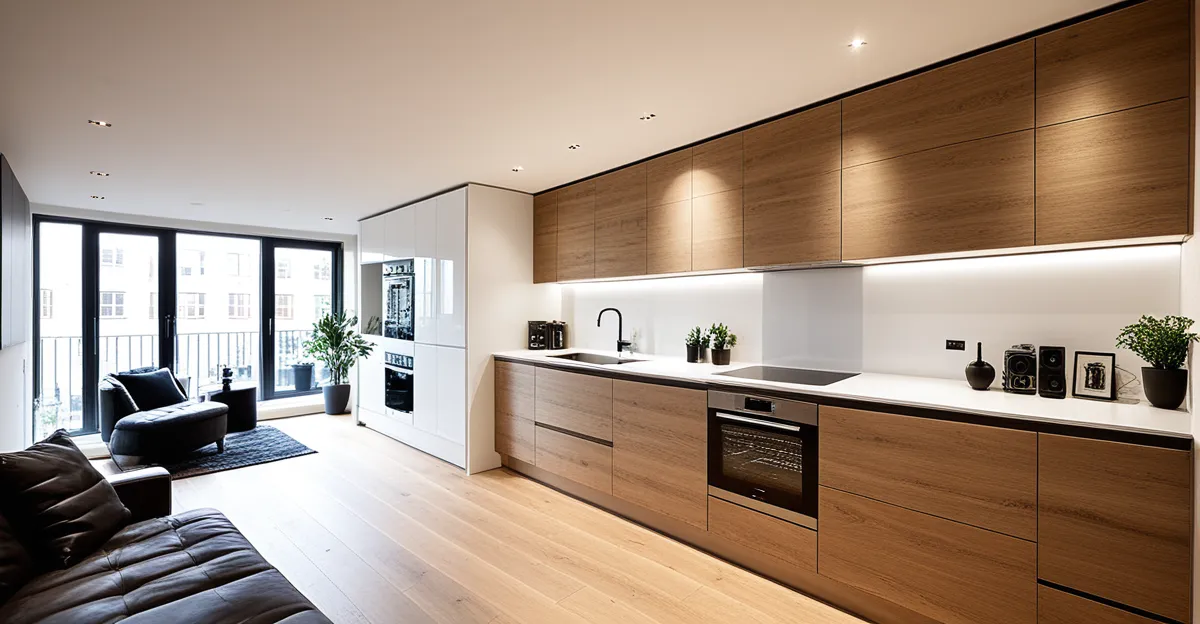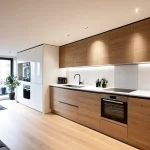Essential Principles for Maximising Space in Small UK Apartments
When tackling small apartment design in the UK, understanding key principles is vital. UK flats often feature compact layouts with quirky room proportions and period detailing, posing unique challenges. Maximising every square foot demands a focus on multifunctionality and adaptability.
Unlike larger homes, UK flats frequently need furniture and storage that serve multiple purposes. For example, a sofa bed or an expandable dining table can transform a living room into a guest bedroom or dining area with ease. This flexibility is crucial because UK interior solutions must accommodate varying lifestyles and space limitations without sacrificing comfort.
Topic to read : How can you improve air quality in UK homes naturally?
Space-saving tips tailored for UK apartments emphasise vertical storage and smart zoning. Utilising underused areas—like alcoves or narrow corners—helps create room for essentials while maintaining a clutter-free environment. Planning a layout that allows smooth movement and natural light enhances the perception of space.
Ultimately, embracing adaptable designs and prioritising furniture pieces that combine function supports efficient small apartment living. This approach suits both modern and traditional UK flats, navigating layout peculiarities while improving daily usability.
Topic to read : What are the benefits of integrating renewable energy sources in your UK home?
Smart Layouts and Furniture Placement
Successfully arranging apartment layouts in UK flats requires careful planning to maximise tight spaces. An open-plan concept often works best, merging kitchen, dining, and living zones seamlessly. This unified layout reduces visual clutter, making the flat feel larger and more inviting.
Positioning large pieces strategically is essential. For example, placing a sofa against a long wall frees up central space for movement and additional furniture. Avoid blocking natural light sources like windows, as this preserves brightness—key in smaller UK homes.
Adapting to irregular floorplans common in British flats demands flexibility. For instance, utilising flexible furniture—like foldable tables and stackable chairs—can accommodate different activities throughout the day. These choices complement the overall flow and respond to quirky room shapes. By combining zoned areas with adaptable fittings, residents can optimise both comfort and utility despite spatial limitations.
In summary, effective UK flat arrangements rely on open or semi-open plans, thoughtful placement, and flexible furnishings. These tactics directly address layout challenges typical of UK interiors. They ensure practical use of each square foot, enhancing everyday living without overcrowding.
Multifunctional Furniture for Enhanced Utility
Multifunctional furniture is fundamental in small apartment design because it directly addresses limited floor space while increasing usability. Popular space-saving furniture UK options include sofa beds, ottomans with hidden storage, and fold-out desks. These pieces enable a single item to serve several functions, a necessity in compact UK interiors.
Customisable furniture offers tailored solutions, fitting awkward layouts common in UK flats. Modular shelving or stackable seating can be rearranged to match evolving needs. For example, a fold-away dining table creates extra space when not in use, optimizing both utility and comfort.
Affordable options are widely available from UK retailers, making multifunctional pieces accessible. Shops often provide designs that blend style with practicality, meeting the demands of diverse budgets and tastes. By choosing convertible furnishings thoughtfully, residents enhance their living experience without overcrowding.
In essence, multifunctional furniture maximizes functionality and adaptability—key principles in effective UK interior solutions for small flats. This approach supports flexible living environments and ensures every square foot is optimally used for daily activities and guest accommodation alike.
Creative Storage Solutions for Clutter-Free Living
Optimising storage is crucial in small apartment design, especially in UK flats where space is limited. Clever UK flat organisation relies on hidden storage to maintain tidiness without encroaching on living areas. Under-bed drawers, wall-mounted shelves, and built-in cupboards are prime examples. These solutions use often-overlooked spaces, increasing storage without clutter.
Utilising awkward corners effectively is another vital space-saving tip. Corner shelves or bespoke cupboards can transform these tricky areas into usable zones. Vertical storage is equally important; tall shelving units or hanging racks maximise height, creating additional capacity without sacrificing precious floor space. Many UK apartments feature alcoves or niches; custom shelving here offers tailored storage that fits the unique layout.
Real-life storage hacks from British apartment dwellers frequently involve multifunctional items like ottomans with compartment space or beds with lift-up bases. Combining these with modular units allows residents to adapt their storage as needs change. Applying these UK interior solutions encourages a clutter-free environment, reducing stress and making small flats feel more open and manageable.
Visual Tricks with Colour and Lighting
Small apartment design in UK flats benefits immensely from smart colour schemes for small spaces and thoughtful lighting design UK. Lighter shades like soft creams, pale greys, and muted pastels reflect light, making rooms feel larger and more open. Matte finishes minimise glare, whereas satin or eggshell finishes subtly enhance light bounce without harsh reflections.
Strategically placed lighting fixtures amplify spatial perception. Layered lighting—combining ceiling lights, wall sconces, and task lamps—provides flexibility and avoids dark, cramped corners. For UK interior solutions, using dimmable LED lights enhances ambiance and energy efficiency, crucial for period flats with limited wiring options.
Mirrors and reflective surfaces further enlarge the visual footprint. Positioning a mirror opposite a window doubles natural light intake, creating depth and brightness. Glossy furniture or metallic accents aid in scattering light subtly across the room.
Employing these space-saving tips with coordinated colour palettes and versatile lighting improves the overall feel, making small UK apartments appear airy and inviting. Thoughtful colour and illumination choices complement other optimisation tactics, offering a cost-effective way to enhance compact living environments without sacrificing style or functionality.
Essential Principles for Maximising Space in Small UK Apartments
Small apartment design in the UK faces distinct challenges due to compact layouts, unusual room shapes, and period features. These factors limit space but also inspire innovative UK interior solutions centred on making the most of every inch. Central to this is embracing multifunctionality—furniture and storage that serve several purposes, such as sofa beds or nesting tables, which adapt to changing needs and activities.
Adaptability is equally crucial; rather than fixed arrangements, residents benefit from flexible setups that evolve with lifestyle shifts. This may include modular furniture or versatile storage units that can be reconfigured as required. Such approaches respond well to irregular British floorplans that often depart from standard rectangular rooms.
Other key space-saving tips focus on utilising overlooked areas creatively, including vertical storage and transforming alcoves. By combining multifunctional furnishings with room-specific adaptations, residents achieve efficient, clutter-free living that balances comfort and style despite the spatial constraints common in UK flats. This comprehensive principle foundation supports practical, flexible, and aesthetically pleasing small apartment environments.
Essential Principles for Maximising Space in Small UK Apartments
In small apartment design, addressing the unique challenges of UK flats is essential for effective space utilisation. Often characterised by compact layouts, irregular room shapes, and period features, these apartments require tailored UK interior solutions that prioritise multifunctionality and adaptability.
Multifunctionality means incorporating furniture or storage that serves multiple roles, such as sofa beds or nesting tables. This approach maximises utility without overcrowding limited floor space. Adaptability further involves flexible arrangements—modular furniture or units that can shift according to changing needs are particularly valuable in UK flats, where layouts rarely conform to uniform dimensions.
Space-saving tips also include exploiting vertical space and transforming alcoves or awkward corners into storage or activity zones. This use of underexploited areas helps maintain a clean, clutter-free environment that feels more spacious.
Combining these principles allows residents to overcome spatial constraints, ensuring comfort without sacrificing style. Understanding and applying these focused strategies is key to successful small apartment living across diverse UK interiors.
Essential Principles for Maximising Space in Small UK Apartments
In small apartment design, especially within UK flats, the primary challenge lies in optimising space amid compact, irregular layouts often featuring period elements. These quirks demand bespoke UK interior solutions that prioritise multifunctionality and adaptability. Furniture and storage must serve dual or multiple purposes to make the best use of limited square footage.
Why is multifunctionality so important? A piece like a sofa bed or nesting tables combines seating and sleeping or dining functions, eliminating the need for separate bulky furniture. This directly addresses spatial limitations by reducing clutter without compromising utility.
Adaptability enhances this by promoting flexible arrangements. Modular units, for example, can be reconfigured to suit evolving activities or seasonal needs, reflecting the diverse lifestyles common in British flats.
Applying smart space-saving tips such as exploiting vertical space and underutilised alcoves is equally vital. These strategies transform awkward corners into functional storage or display zones, maintaining a clean, open feel while maximising available capacity.
Together, these core concepts form the foundation of effective UK interior solutions that tackle the challenges unique to small UK apartments.





